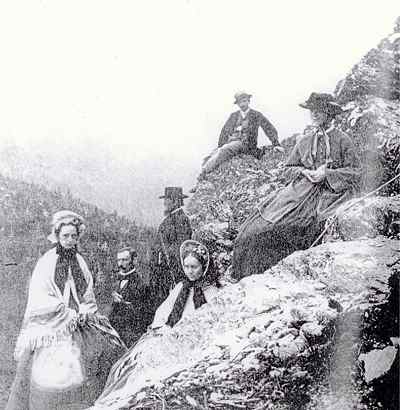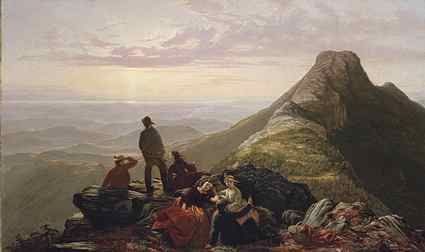
Petticoats and Palettes: Dress and Women Painters of the Hudson River School
By Olivia H. Good
What would the women artists featured in this exhibition have worn when painting or sketching in the Catskills, the Adirondacks, or the White Mountains? The question is not a frivolous one, since the impracticalities of nineteenth-century fashionable dress constituted a very real obstacle for women hoping to experience and capture the American wilderness in plein air.
Until the mid-1850s, women generally wore several layers of thick, heavy petticoats beneath their skirts. These layers were subsequently replaced by the much lighter-weight and less bulky cage crinoline (or hoop skirt). The new crinoline may have been an improvement, but it could still be quite unwieldy, especially as its width steadily increased throughout the period c. 1856-1865. Further, a small waist was desirable throughout the mid-late-nineteenth century and was achieved through corseting, a source of additional discomfort.
During this period, some physicians (many of whom were beginning to recommend regular exercise for women) joined advocates for women's rights in promoting women's dress reform. These physicians recognized that fashionable women's attire was too tight, too heavy, and too cumbersome; it hampered women from moving freely and therefore prevented them from getting the exercise and fresh air that good health required. While the more radical elements of dress reform were never widely adopted -- for example, the early-1850s-era campaign to make the wearing of bloomers (voluminous, ankle-length pants with gathered ankles) underneath a knee-length skirt acceptable for everyday wear was met mainly with derision -- according to Patricia Cunningham, the author of Reforming Women's Fashion, 1850-1920: Politics, Health, and Art, reformers did succeed in making modified trousers (or a skirt worn over trousers) an option for mid-to- late-nineteenth-century women participating in activities like bicycling and hiking. [1]
In fact, as early as 1840, Elizabeth Cady Stanton (1815-1902), the leading figure associated with the earliest wave of the American women's rights movement, wore a short, loose-fitting dress (along with tall boots) while hiking with her husband in Scotland. [2] Overseas, an even more illustrious woman, Queen Victoria, reputedly wore a shortened skirt with a blouse and heavy boots while hiking in Scotland during the 1850s. As a monarch, Victoria was undoubtedly less constrained than other women (after all, who could stop her from wearing what she wanted?); however, her dress was much publicized and her willingness to modify her dress when necessary must have been influential in America as well as in Britain.[3]
Cunningham also suggests, however, that only the most daring adopted reforms like these, while the vast majority of women continued to wear long skirts even while engaged in hiking, tennis, and horseback riding. [4] 'Ordinary' women often made do with more subtle, less shocking modifications: they wore ankle-length (rather than floor-length) skirts, hid trousers under their full-length skirts, or attached small rings to their skirts so that they could be tied up with strings while climbing. [5] A photograph dating to the 1860s [FIG. 1] shows three men and three women perched atop Mount Mansfield, the tallest mountain in Vermont. The women's dress exhibits no obvious concessions to what must have been a strenuous hike -- all three wear long, full skirts, and the woman at the left appears to be wearing a hoop under her skirt. Jerome B. Thompson (1814-1886)'s 1858 painting The Belated Party on Mansfield Mountain [FIG. 2] depicts three men and three women atop the same summit; just like in the aforementioned photograph, all three women are dressed in clothing that must surely have impeded them.

FIG. 1: Frank F. Currier, "Chin From the Nose, Mansfield Mountain," photograph. Original reproduced in Jan Albers, Hands on the Land: A History of the Vermont Landscape (Cambridge, Mass.: Published for the Orton Family Foundation, Rutland, Vt. by MIT Press, 2000), 240.

FIG. 2: Jerome B. Thompson (American, 1814-1886), The Belated Party on Mansfield Mountain, 1858, oil on canvas, 38 x 63 1/8 inches. The Metropolitan Museum of Art, Rogers Fund, 1969 (69.182).
Yet surviving accounts suggest that determined women did not let impractical clothing slow them down. The artist Edith Wilkinson Cook (?-1902) and her niece Marian Pychowska managed to make their way through vast, unexplored stretches of the White Mountains and to shimmy up trees (for better views) in spite of their long skirts. Marian wrote about this in a letter to a female friend: "You wonder how my aunt and I climb treesThe getting up is very easy as the skirts come naturally after. A graceful descent is more difficult, as the same skirts are apt to remain above, but my uncle and Mr. Peek considerately left us, so that grace did not have to be considered." [6]
1 Patricia A. Cunningham, Reforming Women's Fashion, 1850-1920: Politics, Health, and Art (Kent, Ohio: Kent State University Press, 2002), 27-9; 204.
2 Cunningham, Reforming Women's Fashion, 60; Shirley Sargent, Pioneers in Petticoats (Los Angeles: Trans-Anglo, 1966), 395; Lois W. Banner, American Beauty (Chicago: University of Chicago Press, 1984), 88; Elizabeth Smith Miller, "Reflections on Women's Dress and the Record of a Personal Experience," Symposium on Women's Dress, Arena 6 (September 1892): 493-94.
3 Banner, American Beauty, 98.
4 Cunningham, Reforming Women's Fashion, 204.
5 Catherine Smith and Cynthia Greig, Women in Pants: Manly Maidens, Cowgirls, and Other Renegades (New York: Abrams, 2003), 167; Dorothy Middleton, Victorian Lady Travellers (New York: Rawson, Wade, 1979), 10.
6 Cited in Julie Boardman, When Women and Mountains Meet: Adventures
in the White Mountains (Etna, N.H.: Durand Press, 2001), 63. No date
is given.
About the author
Olivia H. Good is Research Assistant at Hawthorne Fine
Art. Ms. Good researched and authored the above essay prepared in connection
with the exhibition Remember the Ladies: Women Artists
of the Hudson River School.
Resource Library editor's note:
The above essay was reprinted in Resource Library on May 17, 2010, with permission of Hawthorne Fine Art, which was granted to TFAO on May 6, 2010.
Resource Library wishes to extend appreciation to Marcia Clark of Shameless Promotions, LLC for her help concerning permissions for reprinting the above essay.
For biographical information on artists referenced in this essay please see America's Distinguished Artists, a national registry of historic artists
![]() Return to Remember
the Ladies: Women Artists of the Hudson River School.
Return to Remember
the Ladies: Women Artists of the Hudson River School.
Links to sources of information outside of our web site are provided only as referrals for your further consideration. Please use due diligence in judging the quality of information contained in these and all other web sites. Information from linked sources may be inaccurate or out of date. TFAO neither recommends or endorses these referenced organizations. Although TFAO includes links to other web sites, it takes no responsibility for the content or information contained on those other sites, nor exerts any editorial or other control over them. For more information on evaluating web pages see TFAO's General Resources section in Online Resources for Collectors and Students of Art History.
Search Resource Library for thousands of articles and essays on American art.
Copyright 2010 Traditional Fine Arts Organization, Inc., an Arizona nonprofit corporation. All rights reserved.